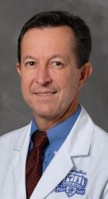
A Wayne State University School of Medicine alumnus has been inducted into the Space Technology Hall of Fame for his work with ultrasound technologies developed for use in manned space flights that are now adapted for practice on earth
Scott Dulchavsky, M.D., Ph.D., Class of 1983, was inducted into the Space Foundation's Space Technology Hall of Fame on April 11. The hall, established in 1988, was designed to increase public awareness of the benefits that result from space exploration programs and encourage further innovation. Induction, according to the foundation, "honors world class technology and those who transform technology originally developed for space exploration into products that help improve the quality of life here on Earth."
"It's a great honor to receive this award on behalf of my entire team. This enabling technology development began with a space program need, was modified and improved by many astronaut and ground personnel, and finally matured into a product that benefits not only NASA, but more importantly, medical care on the planet. My introduction to the space program began with an astronaut classmate at Wayne State University, so I feel that this university shares in this award as well," said Dr. Dulchavsky, chair of the Department of Surgery at Henry Ford Hospital and professor of Surgery, Molecular Biology, and Genetics at the WSU School of Medicine.
He was honored as the principal investigator for the Advanced Diagnostic Ultrasound in Microgravity experiment, a collaboration of Henry Ford Hospital, Johnson Space Center and Wyle Laboratories Inc. He led a team that used small, portable ultrasound devices to train astronauts aboard the International Space Station from 2003 to 2005 so they could obtain diagnostic-quality medical images transmitted by satellite to earth, where radiologists can read them. The experiment showed the effectiveness of ultrasound as a remote diagnostic tool and serves in place of bulky X-ray equipment difficult to accommodate on the space station.
Dr. Dulchavsky leads the ultrasound technology efforts for NASA's space program. He is responsible for ultrasounds and ultrasound technology involving all United States astronauts, Russian cosmonauts and taikonauts of China.
He has since worked with the Detroit Red Wings to test the technology. A portable ultrasound device was placed in the team's locker room and connected to an ultrasound workstation at Henry Ford Hospital, where a radiologist guided team trainers to perform ultrasounds and send images for diagnosis.
His research with space explorers was modified for use on Earth, and his team now supports the onsite care of professional sports teams and United States Olympic Committee athletes as well as the Olympic Games. His team works with worldwide organizations, including the United Nations, to enhance point-of-care ultrasound in underserved areas through remote ultrasound guidance and to support maternal care. NASA also funds his work to establish micro-invasive surgical techniques in zero gravity through the National Space Biomedical Research Institute, Smart Medical Systems Team.
Thanks to Dr. Dulchavsky's work with NASA and General Electric, the manufacturer donated 30 of its portable ultrasound devices to the Wayne State University School of Medicine. Each device costs about $70,000. First-year students, starting with the Class of 2006, now have hands-on ultrasound training in how to use the devices, which look like slightly beefed-up versions of laptop computers. The School of Medicine was the first medical college in the nation to secure the technology produced by GE Healthcare and incorporate it into the first-year curriculum for 300 students.
"Because of this equipment, our students, when they get to the stage of seeing standardized patients in their third and fourth years, and residency, they are ahead of other students," said medical student Michelle Campbell, who has completed the ultrasound training and has assisted first-year students in their training. "They have an edge because at most medical schools students don't begin this type of experience until their third or fourth year."
Dr. Dulchavsky shares his passion for ultrasound technology because the medical students will eventually face the decision of purchasing such equipment for their own practices, or will serve in decision-making positions for hospitals and surgical centers investigating ultrasound equipment.
In a recent session, the medical students also explored the future of ultrasound science. Dr. Dulchavsky brought with him an even smaller portable version - about the size of an iPod without the wand - that the students also tested.
Like computers, ultrasound technology is getting better, smaller and less expensive. Dr. Dulchavsky is experimenting with an ultrasound device that can hook up to his cell phone. He believes the use of the technology in space will one day allow physicians to diagnose and provide treatment to patients in remote locations around the planet.